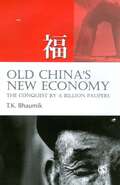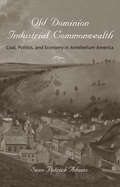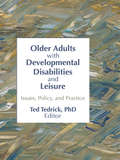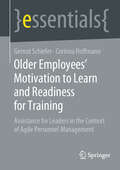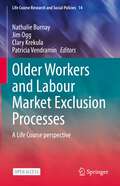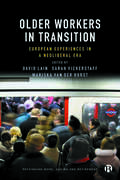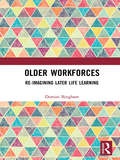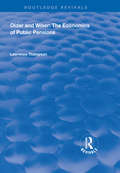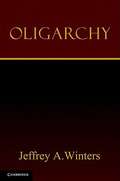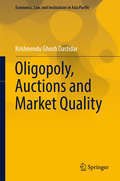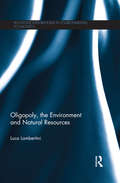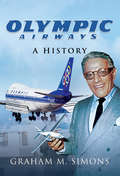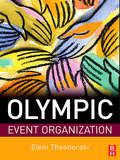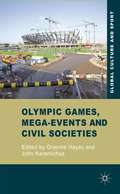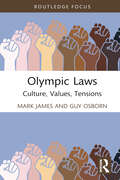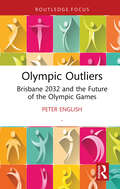- Table View
- List View
Old China′s New Economy: The Conquest by a Billion Paupers
by T K BhaumikThis book presents a comprehensive analysis of the rise and growth of the Chinese economy since the beginning of the country′s transition to a socialist market economy, and captures the growth story in its historical backdrop. It sequentially unveils the story, and highlights the critical role of two major change agents—the government and the people. While the credit goes to the former for the successful transition to a high growth economy, there is an equally important role played by the Chinese people, displayed by their hard work, tenacity and struggle for a better living standard. The book provides a complete account of this transition from the pre-revolution feudalistic China to where it stands today as a viable market economy. It analyses the key drivers of high growth and has delved into the much debated and discussed issue of sustainability. The author has analysed in detail numerous challenges that high growth has thrown up for the people and the government. It is argued that China is likely to see its high growth continuing for many years to come, after having already secured a high pedestal in the global economy. This book will prove valuable insight for China observers, political economists, business analysts, serious media, and students and teachers of development economics.
Old Dominion Industrial Commonwealth: Coal, Politics, and Economy in Antebellum America (Studies in Early American Economy and Society from the Library Company of Philadelphia)
by Sean Patrick AdamsA look at the role of state policies in North-South economic divergence and in American industrial development leading up to the Civil War.In 1796, famed engineer and architect Benjamin Henry Latrobe toured the coal fields outside Richmond, Virginia, declaring enthusiastically, “Such a mine of Wealth exists, I believe, nowhere else!” With its abundant and accessible deposits, growing industries, and network of rivers and ports, Virginia stood poised to serve as the center of the young nation’s coal trade. By the middle of the nineteenth century, however, Virginia’s leadership in the American coal industry had completely unraveled while Pennsylvania, at first slow to exploit its vast reserves of anthracite and bituminous coal, had become the country’s leading producer.Sean Patrick Adams compares the political economies of coal in Virginia and Pennsylvania from the late eighteenth century through the Civil War, examining the divergent paths these two states took in developing their ample coal reserves during a critical period of American industrialization. In both cases, Adams finds, state economic policies played a major role. Virginia’s failure to exploit the rich coal fields in the western part of the state can be traced to the legislature’s overriding concern to protect and promote the interests of the agrarian, slaveholding elite of eastern Virginia. Pennsylvania’s more factious legislature enthusiastically embraced a policy of economic growth that resulted in the construction of an extensive transportation network, a statewide geological survey, and support for private investment in its coal fields.Using coal as a barometer of economic change, Old Dominion, Industrial Commonwealth addresses longstanding questions about North-South economic divergence and the role of state government in American industrial development.
Old News
by Liz HuyckPeople have always liked to know what's going on in the outside world. Today we can instantly access the news through the Internet. But how did people get the news before cell phones and TV? From ancient Rome to newspapers and telegraph machines, this story takes a brief look at how people have gotten the news throughout history.
Old and New Roads to Mandalay: Hard Power in Burma and Beyond
by Tarun KhannaThis chapter shows how China is expanding its hard power-won through military and economic domination and illustrated most dramatically by its insatiable quest for oil-and discusses the implications of that expansion for Southeast Asia and the rest of the world.
Old-Age Provision and Homeownership – Fiscal Incentives and Other Public Policy Options
by Jörg Dötsch Martina Eckardt Stefan OkruchIn light of demographic change and the growing problems of traditional old-age security systems, this book discusses two essential instruments in connection with privately providing for old-age security: (1) savings in private pension schemes and (2) building up equity for home-ownership. Further, it assesses the relationship between the two instruments and offers a unique overview of the latest market developments.In order to represent the profound differences between the individual member states of the EU, this book features six country-specific studies – covering Germany, Hungary, Ireland, Italy, the Netherlands and the United Kingdom – that provide detailed insights into the complexity of local private pension schemes, mortgage markets, and housing markets. Lastly, the book discusses public policies and fiscal incentives intended to better integrate residential property with private pensions. It will appeal to both, private households seeking to build up old-age security, as well as policy makers interested in providing secure pension schemes.
OldTown Berhad
by Benjamin C. Esty Greg SaldutteCase: Professor Benjamin C. Esty and Research Associate Greg Saldutte prepared this case. This case was developed from published sources. Funding for the development of this case was provided by Harvard Business School and not by the company. HBS cases are developed solely as the basis for class discussion. Cases are not intended to serve as endorsements, sources of primary data, or illustrations of effective or ineffective management.
Older Adults With Developmental Disabilities and Leisure: Issues, Policy, and Practice
by Ted TedrickIf you work with older adults who are developmentally disabled and are seeking ways to incorporate exercise, arts activities, and other activities into your program, this is the book for you! Older Adults With Developmental Disabilities and Leisure will help you improve your ability to instruct exercise and other fitness activities and, at the same time, increase your knowledge about aging and mental retardation and developmental disabilities. This combination of skills and knowledge is important to your understanding of your clients and their needs. You will assist them in leading a more active, structured life that will result in a higher sense of satisfaction in their daily living and health benefits that will speak for themselves.Older Adults With Developmental Disabilities and Leisure gives you specific guidelines for establishing fitness programs as well as ideas for offering clients goals and incentives that will evoke and maintain their enthusiasm to participate. Using a proven model, the Arts/Fitness Quality of Life Activities Program, the authors show how careful planning and sequencing can produce successful results, such as peer interaction, flexible thinking, self-expression, and improved mental health. As you learn about the key factors for programming for this group of clients, you will also learn about: the demographics of this population leisure education training and cross-training with aging specialists and mental retardation staff community integration and for whom it is appropriate inactivity in later life and the complications it causes life satisfaction and leisure participation differences in physical and cognitive functioning among this population consumer satisfaction among older adults with developmental disabilitiesIt is never too late to introduce leisure activities into the lives of those with developmental disabilities. With encouragement and careful guidance, you can lead your elders/clients into a more active and healthy life. Use Older Adults With Developmental Disabilities and Leisure as a guide to find activities and exercise programs that are appropriate, fun, and worthwhile!
Older Employee's Motivation to Learn and Readiness for Training: Assistance for Leaders in the Context of Agile Personnel Management (essentials)
by Gernot Schiefer Corinna HoffmannThe motivation of older employees to learn is a complex psychological construct that has hardly been addressed to date. In times of demographic change, it is of central importance to motivate older employees for continuous training in order to keep them employable. With increasing age, changes in learning and performance as well as a decreasing motivation for further vocational training become apparent. Gernot Schiefer and Corinna Hoffmann show connections between motivation, performance and learning behavior and analyze motivational factors and learning obstacles of older employees. In a practical manner, the authors present possibilities for companies to actively contribute to promoting the learning motivation of their older employees.The Authors:Prof. Dr. Gernot Schiefer teaches business psychology and human resource management at the FOM University of Applied Sciences in Mannheim and works as a coach and consultant. Corinna Hoffmann, M. Sc. works in the human resources department of an international consumer goods manufacturer.This Springer essential is a translation of the original German 1st edition essentials, Lernmotivation und Weiterbildungsbereitschaft älterer Mitarbeiter by Gernot Schiefer and Corinna Hoffmann, published by Springer Fachmedien Wiesbaden GmbH, part of Springer Nature in 2019. The translation was done with the help of artificial intelligence (machine translation by the service DeepL.com). A subsequent human revision was done primarily in terms of content, so that the book will read stylistically different from a conventional translation. Springer Nature works continuously to further the development of tools for the production of books and on the related technologies to support the authors.
Older Workers and Labour Market Exclusion Processes: A Life Course perspective (Life Course Research and Social Policies #14)
by Jim Ogg Patricia Vendramin Clary Krekula Nathalie BurnayThis open access book addresses the important and neglected question of older workers who are excluded from the labour market. It challenges post-capitalist discourses of active ageing with a focus on restrictive end-of-career and retirement measures. The book demonstrates how a paradigm shift is generating real processes of exclusion for important sectors of the population. By providing strong empirical evidence from different contexts, the impact of different life course trajectories on the risks and the opportunities at the end of career are demonstrated. The organisation of workplace and institutional frameworks which reinforce inequalities are also presented. As such the book is an essential reading for students, academics and policy makers who seek to understand how exclusion processes operate to the disadvantage of older workers in the labour market.
Older Workers in Transition: European Experiences in a Neoliberal Era (Rethinking Work, Ageing and Retirement)
by David Lain, Sarah Vickerstaff and Mariska van der HorstMore people are extending their working lives through necessity or choice in the context of increasingly precarious labour markets and neoliberalism. This book goes beyond the aggregated statistics to explore the lived experiences of older people attempting to make job transitions. Drawing on the voices of older workers in a diverse range of European countries, leading scholars explore job redeployment and job mobility, temporary employment, unemployment, employment beyond pension age and transitions into retirement. This book makes a major contribution and will be essential reading within a range of disciplines, including social gerontology, management, sociology and social policy.
Older Workforces: Re-imagining Later Life Learning
by Domini BinghamWe are all going to become old. Many countries are ageing demographically with ageing workforces. Despite anti-discrimination and equality laws, older workers are routinely left out from learning opportunities even unconsciously so, suffer stereotyping or they simply do not participate. Why is this so? This book looks to understand the background to this and re-imagine older workplaces to capitalise on older workers. The author explores what learning and development offers a best fit for older workforces through literature, research and case studies with organisations and individuals. She considers how an organisation might shift its strategic processes to offer a holistic workforce opportunity of value to both employee and employer, as it is cognitive skills that will be needed in future workforces. Emphasising the area of work agency and the human right to learning, this book turns ageing and learning in workplaces on its head, seeing older workers as vessels of untapped potential. It re-imagines their possibilities in a time of intense demographic and digital change. This book will be a pragmatic guide to academics, researchers and practitioners in the fields of workplace learning, human resource development, social policy and diversity.
Older and Wiser: Economics of Public Pensions (Routledge Revivals)
by Lawrence ThompsonFirst published in 1998, this volume was developed as part of the Stockholm Initiative and sets out to assess the situation of providing for retirement and pensions. In the wake of intense debate over pay-as-you-go pensions, Lawrence Thomson for the most part leaves social and cultural issues for subsequent analysis, instead examining the economic
Oligarchy
by Jeffrey A. WintersFor centuries, oligarchs were viewed as empowered by wealth, an idea muddled by elite theory early in the twentieth century. The common thread for oligarchs across history is that wealth defines them, empowers them and inherently exposes them to threats. The existential motive of all oligarchs is wealth defense. How they respond varies with the threats they confront, including how directly involved they are in supplying the coercion underlying all property claims and whether they act separately or collectively. These variations yield four types of oligarchy: warring, ruling, sultanistic and civil. Moreover, the rule of law problem in many societies is a matter of taming oligarchs. Cases studied in this book include the United States, ancient Athens and Rome, Indonesia, the Philippines, Singapore, medieval Venice and Siena, mafia commissions in the United States and Italy, feuding Appalachian families and early chiefs cum oligarchs dating from 2300 BCE.
Oligopoly, Auctions and Market Quality
by Krishnendu Ghosh DastidarTheories of oligopoly and auctions have a direct link with the theory of market quality. Surprisingly, however, this link has not been adequately analysed in the literature. This book fills that gap and focusses on the interconnections between theories of oligopoly, auctions, and market quality. It brings together the relevant theoretical results in the literature on these topics under a unified framework and argues that insights from the theories of oligopoly and auctions can help us understand and analyse problems related to market quality. While the book is mainly theoretical in nature, it also discusses some specific issues related to the problems of market quality in emerging economies like that of India. The book also shows how in such specific cases, insights from the theoretical results on oligopoly and auctions can be used to improve market quality. Illustrated by carefully chosen examples and supported by case studies, this book is highly recommended to readers who seek an in-depth and up-to-date integrated overview of the new field of market quality economics
Oligopoly, the Environment and Natural Resources (Routledge Explorations in Environmental Economics)
by Luca LambertiniIndustrial production and consumption patterns rely heavily on the intensive use of both renewable and non-renewable resources and the consequences for the environment can be serious. Following a long period of time where the profit incentives of firms have prevailed over preservation of the environment and the world’s natural resources, a new consensus has emerged concerning the need to regulate firm behaviour, aimed at ensuring the sustainability of the economic system in the long run. This book offers an exhaustive overview of current economic debate about these topics, taking modern oligopoly theory as a benchmark. The first part of the book covers static models dealing with incentives for green research and development, Pigovian taxation, cartels, environmental quality and international trade, as well as the role of corporate social responsibility, public firms and consumer environmental awareness as endogenous regulatory instruments. Then, the author moves on to examine the role of time while drawing from optimal control and differential game theory. This opens the way to the discussion of fair discount rates to ensure the welfare of future generations, as well as the long run sustainability of production and consumption patterns.
Olivia Lum: Wanting to Save the World
by Geoffrey G. Jones Essie AlamsyahThis case considers the entrepreneurial career of Olivia Lum, who founded the Singaporean water company Hyflux in 1989. An orphan born in Malaysia, Lum provides a rare case of an entrepreneurial success in a country whose economic success has primarily rested on state-owned and foreign firms. The case describes the formidable challenges she initially faced, her subsequent breakthrough in China, and the subsequent growth as a global water treatment company employing membrane technology. In 2004 the company entered the large Middle Eastern market for water treatment but soon encountered problems, including political turbulence. The case ends with demonstrations and an emergent crisis in Libya in 2011, a country in which Hyflux had recently invested. The case offers opportunities to explore the nature of entrepreneurship in Southeast Asia, the business importance of relationships between overseas Chinese and mainland China, and the challenges faced by female entrepreneurs. More broadly, it serves as vehicle for teaching students about the global water crisis and the role of business in helping to resolve it.
Olympic Airways: A History
by Graham M. Simons&“Readers with an interest in the early days of organized civil mass air transport will enjoy having a familiar story be retold from a Greek perspective.&” —SpeedReaders The Olympic Airways story has fascinated Graham M. Simons for many years. This new book represents the culmination of decades spent researching the history of this fascinating Greek airline. It is a story of evolution, conflict, personality and politics, all set against a backdrop of world and civil wars, coups and countercoups. During the course of his research, it became apparent to the author that many of the fine details pertaining to the company weren&’t widely known, although almost everyone had heard of the towering, controversial, leading figurehead who oversaw much of the central part of the story: Aristotle Socrates Onassis. His colorful life is threaded through this history, lending it drama and multiple levels of intrigue. The airline&’s story cannot be told in isolation. Olympic did not spring fully formed into being in 1957. The named company may have come into being then, but its roots were set much further back in history through a number of predecessor airlines—both national and international—who had been using the Hellenic Republic and Athína as the crossroads of the air for the Eastern Mediterranean since the dawn of aviation. This is the story of the birth and dramatic life of an airline with a checkered, controversial and complicated history. Graham M. Simons has skillfully woven all the various threads to create a powerful and important historic record.
Olympic Event Organization
by Eleni TheodorakiOlympic Event Organization is the first text to address a number of important questions in contemporary mega-event management: Which organizations are involved in the Olympic Movement and in what capacity? What are the interorganizational flows of authority and finance between them? How is work grouped, in what unit sizes, how specialized and formalized are work processes? How complex, dynamic, diversified, or friendly is their environment? What are the power issues and how do the technological processes affect these organizations? How do the OCOGs evolve in their life cycle, what pressures shape their structures and management processes and how is work co-ordinated? The examination of the Olympic Games event organization in the 10-year period, from bidding to post-games closing down, draws material from host cities to explore the types of interorganizational flows that take place at various stages for the Olympic Games to be delivered. Knowledge transfer from one host city to the next and an established organizational field also means that management practises sometimes follow some externally imposed organizing logics. The challenges faced by organizers are discussed and the tensions that a strong management template from the IOC creates are also examined. Finally, the issue of sustainability of the Olympic Games is identified along with an analysis of the ways in which the concepts of impact are appropriated by the various stakeholders involved with the Olympic Games as they attempt to influence public opinion.Written in an accessible and insightful manner Olympic Event Organization is essential reading for both academics and practitioners alike.
Olympic Games, Mega-Events and Civil Societies
by Graeme Hayes John KaramichasThis volume explores sporting mega-events, their social, political, and cultural characters, the value systems that they inscribe and draw on, the claims they make on us and the claims the organisers make for them, the spatial and ethical relationships they create, and the responses of civil societies to them.
Olympic Laws: Culture, Values, Tensions (Routledge Focus on Sport, Culture and Society)
by Mark James Guy OsbornOlympic Laws: Culture, Values, Tensions is the first book to analyse fully the Olympic legal framework and its application to the IOC and the Olympic Games through a socio-legal lens. It opens up a new window into understanding the Olympic Games across recent iterations of the Games and on to future Games. The book begins by defining the parameters of the emergent legal sub-fields of Sports Law, lex Olympica and Olympic Law, through the identification of the sources of these Olympic Laws and their underpinning norms. It then uses a series of case studies to demonstrate how lex Olympica has evolved as a means of defending the Olympic Movement from unwanted legal interventions, how Olympic Law has been created to protect the commercial rights vested in the Games, and how the legacies created by this unique category of law have a lasting impact on host cities and beyond. It concludes with a call that the IOC should recalibrate its relationships with prospective hosts and the participating athletes by requiring specific adherence to the Fundamental Principles of Olympism. This is essential reading for any student or researcher with an interest in Olympic studies, sports law, or socio-legal studies or any practising lawyer or events professional looking to better understand the impact and institutions of mega-events.
Olympic Marketing
by Jean-Loup Chappelet Alain Ferrand Benoit SeguinThe Olympic Games have become the definitive sports event, with an unparalleled global reach and a remarkably diverse constituency of stakeholders, from the IOC and International Federations to athletes, sponsors and fans. It has been estimated, for example, that 3.6 billion people (about half of the world population) watched at least one minute of the Beijing Games in 2008 on television. The driving force behind the rise of the modern Olympics has been the Olympic marketing programme, which has acted as a catalyst for cooperation between stakeholders and driven the promotion, financial security and stability of the Olympic movement. This book is the first to explain the principles of Olympic marketing and to demonstrate how they can be applied successfully in all other areas of sports marketing and management. The book outlines a strategic and operational framework based on three types of co-productive relationships (market, network and informal) and explains how this framework can guide professional marketing practice. Containing case studies, summaries, insight boxes and examples of best practice in every chapter, this book is important reading for all students and practitioners working in sports marketing, sports management or Olympic studies.
Olympic Outliers: Brisbane 2032 and the Future of the Olympic Games (Routledge Focus on Sport, Culture and Society)
by Peter EnglishThis book examines the significance of the Brisbane Olympics and Paralympics, taking place in 2032, in the context of the history and future of the Olympic Movement.As an outlier host, Brisbane is an experiment towards a new Olympic and Paralympic future. In an era of rising costs, the Brisbane Games represent a significant shift away from megacities towards a more sustainable future for the Olympics. Drawing on research including media analysis, published interviews and official documents, and considering host cities and nations, legacies, athletes and Olympic history, this book examines the viability of Olympic outliers and asks whether they might develop into the Olympic mainstream.This is an important read for anybody with an interest in the Olympics, sport history, sport media, sport governance and policy, or events.
Olympic Rent-A-Car U.S.: Customer Loyalty Battles
by John Deighton James KindleyThe marketing and operations managers for Olympic Rent-A-Car meet to decide how to respond to changes in the loyalty rewards program at the market-leading competitor. The competitor's program gives awards based on dollars spent instead of days rented and eliminates blackout dates. Olympic expects the program to capture more of the valuable business traveler segment, which rents cars more frequently and generally pays higher premiums than the leisure traveler segment. At the meeting, the team reviews the financial performance of the firm and the firm's reward program, called Olympic Medalist. They consider whether they can afford to match the competitor's loyalty program terms as they have done in the past and also consider how the competitor's actions will affect the entire car rental industry. Ultimately, they must respond with a truly distinctive strategy. Students must perform a quantitative analysis of each possible response and consider the value of customers in loyalty programs.
